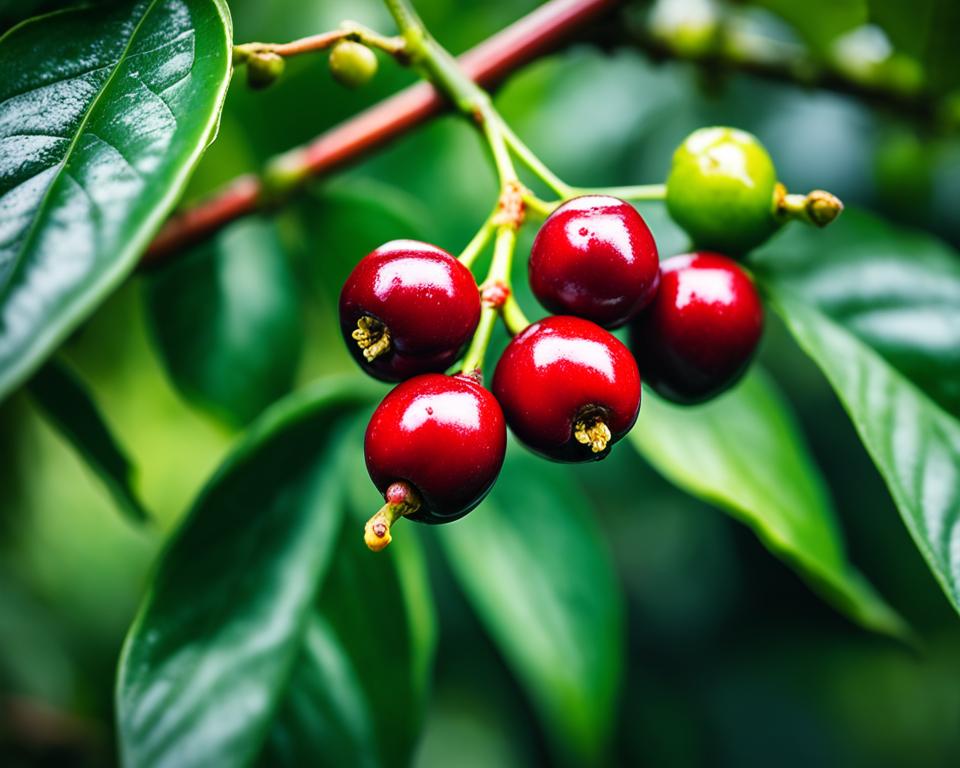Only about 5–10% of the world’s coffee production consists of Tanzanian peaberry. These rare beans are unique because they grow single and round. Unlike regular beans, this shape gives Tanzanian peaberry a more intense flavour.
In my quest for the perfect cup, I discovered Tanzanian peaberry. It is not just delicious; it shares a story of tradition and excellence.
Key Takeaways
- Tanzanian peaberry represents only about 5–10% of global coffee production.
- Peaberry beans develop singly inside the coffee cherry, offering a unique flavour.
- Coffee enthusiasts celebrate this coffee as a top-tier choice within the realm of specialty and gourmet coffee.
- Its rich heritage and premium quality make it unique.
- For coffee enthusiasts, Tanzanian peaberry’s distinct flavour and story make it a must-try.
What makes Tanzanian peaberry coffee unique?
Tanzanian peaberry coffee is special among African coffees. It stems from a unique genetic trait. This trait forms rare peaberry beans, offering coffee enthusiasts a one-of-a-kind taste.
The Peaberry Phenomenon
Most coffee cherries have two beans each, but not peaberries. When only one oval-shaped bean grows in the cherry, it creates a peaberry bean.
This single, dense bean roasts more evenly. Experts believe the coffee’s flavour stands out because of this.
Flavour Profile
Tanzanian peaberry’s taste is full of life and variety. Fans mention tasting citrus and enjoying a silky, chocolate ending. This pairing makes each cup stand out, drawing praise from around the globe.
Compared to other coffee beans
Compared to normal beans, Tanzanian peaberries have a bolder, more rich flavor. They also tend to be more acidic, adding a sprightly taste.
This unique blend is what makes them popular with coffee fans everywhere.
The Cultivation Process of Tanzanian Coffee
Tanzanian coffee is grown with great care, following old traditions. The process focuses on being good for the earth. Knowing how it’s grown can make you love the taste even more.
Ideal Growing Conditions
Tanzanian coffee loves special environments. Areas like Mount Kilimanjaro have the right soil and altitude. This helps the coffee plants grow strong and flavorful beans.
Harvesting peaberry beans
Gathering peaberry beans is done with a lot of attention. Farmers pick them by hand, as they look different from other beans. This careful process ensures that only the best beans are chosen, giving coffee lovers a top-notch choice.
Sustainable practices in Tanzania
In Tanzania, protecting the environment and fair trade are top goals. Many coffee farms are eco-friendly. They work hard to treat the land well and pay their workers fairly.
This helps both the earth and the people who grow our coffee.
The Journey from Coffee Cherry to Peaberry Bean
The journey from coffee cherry to peaberry bean is quite detailed. It’s about selecting only the best beans. These careful steps make sure you get top-quality coffee in your cup.

Processing Methods
There are two main ways to process the beans: washed and natural. The washed method takes the skin off, lets it ferment, and then it’s washed.
The natural method lets the beans dry with the whole cherry on, adding a fruity taste to them.
Drying and milling
The next step is drying the beans just right to keep their quality. They can dry in the sun or by machine. After drying, they remove the outer layer and make the beans the right size.
Quality Control
Checking the beans for top quality is super important. Experts look at the beans for any faults, their size, and how they might taste. This careful process makes sure that only the best beans are called Tanzanian peaberries, making coffee fans happy all over.
| Stage | Process | Impact |
|---|---|---|
| Selection | Handpicking | Ensures high-quality coffee cherry |
| Processing | Washed / Natural | Influences flavor profile |
| Drying | Sun-drying / Mechanical | Maintains optimal moisture content |
| Milling | Hulling and Sorting | Achieves uniformity |
| Quality Control | Grading and Inspection | Ensures only premium coffee beans |
Tasting and Brewing Tanzanian Peaberry Coffee
Discovering Tanzanian peaberry coffee opens a world of joy for all. It’s loved by both new fans and old hands. By using the right brewing methods and pairings, its unique features shine.
Optimal Brewing Techniques
For Tanzanian peaberry, precise brewing is key to enjoying it fully. I recommend pour-over and French press for the best taste. These methods make its rich and lively flavours stand out, showing its full character.
Tasting Notes
Tanzanian peaberry often surprises me with its subtle tastes. I notice lovely hints of peach and black tea, with a touch of dark chocolate. This mix of flavours shows the dedication to growing and processing each peaberry.
Pairings and enjoyment
To elevate your coffee moment, choose your pairings wisely. Try Tanzanian peaberry with foods that make its flavours pop. Good matches are mild cheese like gouda and nuts like almonds.
These enhance its brightness and deep notes.
Why Tanzanian Peaberry is a Must-Try for Coffee Lovers
Are you a coffee lover who always looks for something special? Tanzanian peaberry is a unique coffee that can be your new favourite.
It stands out with its round beans and special taste. It’s not just any coffee; it’s an extraordinary choice for those who truly love their brew.
“Tanzanian Peaberry’s rarity and exceptional taste make it a premium choice for anyone looking to elevate their coffee game.”
Peaberry beans are different from regular ones. They come as single, round beans in the cherry. This unique shape gives them a more powerful flavour.
You’ll taste a rich, full-bodied experience with a touch of lively acidity and smooth chocolate. It’s truly a must-try for anyone who enjoys quality coffee.
Here’s why Tanzanian peaberry should be on every coffee aficionado’s radar:
- Unique Bean Structure: Unlike typical flat-sided coffee beans, peaberries develop as single, round beans inside the coffee cherry, leading to a more concentrated and robust flavour.
- Exclusive Flavour Profile: This coffee presents a delightful mix of citrus undertones and a silky, chocolatey finish, making each cup a new adventure.
- Rarity: Given that only about 5–10% of coffee beans are peaberries, they offer an exclusive, sought-after experience for those who appreciate premium coffee.
| Feature | Tanzanian Peaberry | Regular Coffee Beans |
|---|---|---|
| Bean Structure | Single, round bean | Flat-sided, paired beans |
| Flavor Intensity | More concentrated | Milder |
| Acidity | High, lively | Varies, often lower |
The Tanzanian peaberry has a unique story and taste. It’s not easy to find, which makes it even more special. It deserves a spot on your coffee exploration list.
Enjoy it occasionally or make it your go-to; either way, it guarantees a wonderful coffee experience.
What Makes Tanzanian Peaberry Stand Out Compared to Other Coffee Varieties in Yemen’s Rich Coffee History?
Tanzanian Peaberry stands out for its unique flavor profile and distinct growing conditions. Unlike traditional coffee beans, this coffee has a rounded shape, resulting in a concentrated taste. As yemen’s rich coffee heritage explored reveals, the origin and processing techniques greatly influence the final cup, making Peaberry a delightful contender.
Conclusion
Tanzanian peaberry coffee has amazed me on this trip of exploration. It’s unlike any other coffee because of how it forms and tastes. The peaberry grows uniquely within the coffee cherry. The cultivation in Tanzania is detailed and eco-friendly. Each part makes it stand out in coffee.
Tanzanian peaberry coffee amazes me with its discovery. Every sip shows a mix that is lively and silky. It has flavours of citrus and chocolate. This coffee is more than a drink; it’s an opportunity to enjoy the subtleties of premium African coffee.
In the wide range of high-quality coffee, Tanzanian peaberry is special. It’s more than a beverage; it’s a merging of rareness, taste, and heritage.
For coffee lovers, this unique choice is important. It provides a strong and deep link to the skill of making great coffee. The variety and quality of Tanzanian peaberry coffee highlight the amazing journey from bean to cup. It’s something every coffee lover should try.
FAQ
What makes Tanzanian peaberry coffee unique?
Tanzanian peaberry coffee is special because of its distinct bean. It develops from a single seed inside the coffee cherry, which is uncommon. The resulting beans are rounder and denser. They often produce a more intense, flavorful coffee.
What is the flavour profile of Tanzanian peaberries?
Tanzanian peaberry boasts a complex and lively flavor. You might notice citrus notes with a finish that’s both smooth and chocolatey. These features make it stand out among African coffees. It brings a cup full of life with a hint of sharpness.
How are Tanzanian peaberry beans harvested?
Harvesting Tanzanian peaberry beans involves a detailed process. They’re selected by hand from the regular beans, making the work quite intense. This careful picking guarantees the best quality for these unique beans.
What are the ideal growing conditions for Tanzanian coffee?
Tanzanian coffee flourishes in places like Mount Kilimanjaro and the Ngorongoro crater. These regions offer the perfect mix of mineral-rich soil and high altitudes. These conditions are just right for growing top-notch coffee, including peaberry beans.
What processing methods are used for Tanzanian peaberry coffee?
The path from a coffee cherry to a peaberry bean involves a lot of care and selection. Commonly, these beans are treated using either washed or natural methods. The choice of process has a big impact on the coffee’s final taste.
How should I brew Tanzanian peaberry coffee for the best taste?
To get the most out of your Tanzanian peaberry, try brewing it with methods like pour-over or French press. These approaches can really highlight its vibrant and complex flavours.
What are the tasting notes of Tanzanian peaberry coffee?
Drinking Tanzanian peaberry might reveal flavours of peach, black tea, and a bit of dark chocolate. These notes showcase its deep and rich character.
Why is Tanzanian peaberry coffee considered a must-try for coffee lovers?
Tanzanian peaberry is a unique coffee that stands out for its rare, amazing taste. Every sip is an adventure for your taste buds, making it essential for those who love coffee.
What sustainable practices are used in Tanzanian coffee farming?
Many farmers in Tanzania are turning to sustainable, earth-friendly practices. They also join programmes that support sustainable agriculture. These steps are good for the farmers, the land, and the coffee.




